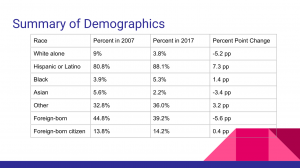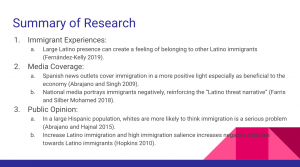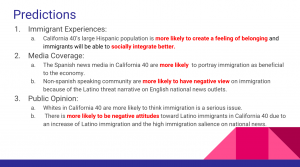

California’s 40th congressional district contains the areas of Downey, Mayhood, Vernon, East Los Angeles, Los Angeles, Bell, Bell Gardens, and more. It’s a mainly Hispanic district with very few whites. In the last ten years, the Hispanic population has increased by 7.3 percentage points while the white population has decreased by 5.2 percentage points. Interestingly the second largest population is “other” which has increased by 3.2 percentage points. The foreign-born population has decreased by 5.6 percentage points but the foreign-born citizens have remained relatively the same.

Fernandez-Kelly (2019) tests the coping strategies of immigrant youth in Princeton and Trenton. She found that while Princeton has great resources for immigrant youth as opposed to Trenton, immigrant youth feel a better sense of belonging in Trenton because there is a larger immigrant population. This means that a larger Latino presence can create a feeling of belonging to other Latino immigrants which can help them socially integrate better. Abrajano and Singh (2009) test the difference in English and Spanish news coverage of immigration. They find that Spanish news has more pro-immigration attitudes and less anti-immigration attitudes. Also, Spanish news portrays illegal immigration to be beneficial to the economy. Farris and Silber Mohamed (2018) tests how national media portrays immigration by looking at how news story photos portray immigration negatively. They found that these images reinforce the Latino threat narrative by portraying immigrants as criminals or not integrating into society. Abrajano and Hajnal (2015) test the consequences of negative attitudes towards immigration. They find that white backlash could be due to a large Hispanic population and interaction making them think immigration is a serious issue. Hopkins (2010) tests why Americans connect local changes to national anti-immigration attitudes. He finds that when there’s a large increase of immigration population at the same time as national salient immigration rhetoric, negative attitudes towards immigration increases.

Based on the literature, I predict that California 40’s large Hispanic population is more likely to create a feeling of belonging and immigrants will be able to socially integrate better. California 40 has a large Hispanic/Latino population which may make other Latinos feel more welcomed and belonging and will allow them to integrate to society better. I also predict that the local Spanish news media in California 40 are more likely to portray immigration as beneficial to the economy which will make Spanish-speakers have more positive views on immigration. However, I predict that the non-Spanish speaking community is more likely to have negative views on immigration because of the Latino threat narrative on English national news outlets. I predict that the whites in California 40 are more likely to think immigration is a serious issue because of their interaction with a large Hispanic/Latino population. I also predict that there is more likely to be negative attitudes toward Latino immigrants in California 40 due to an increase of Latino immigration and the high immigration salience on national news.

I will be testing my prediction on immigrant experiences because in California 40, there is not a lot of immigration help but there is a lot of immigrants so, I’m curious to know about their experience integrating. I will reach out to one of the only immigration help organizations, the Coalition of Humane Immigrant Rights (CHIRLA) in South Los Angeles, and try to interview a staff member. I will ask them a series of questions including: what are immigrants biggest struggle in South LA? In your opinion, do the social class differences in South LA impede the integration of immigrants? On a scale of 1 to 10, how welcomed do immigrants feel in South LA, 10 being very welcomed. What can be done to make immigrants feel more welcomed? I think that these questions will let me know how immigrants in California 40 feel in their district as well as how they think others feel about them. It will let me know if having a large Hispanic/Latino population benefits their social integration.